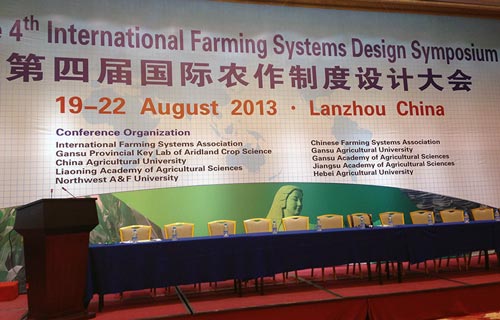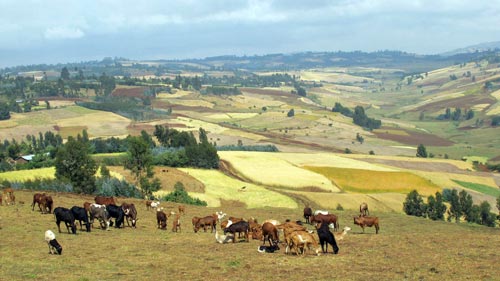 Farming systems all over the world face complex problems in terms of production, such as natural resource depletion, climate change, increasing food demand, and volatile prices. Farmers have to adapt to continuously changing conditions to produce food. ‘Farming systems design’ is an approach that aims at modifying designs of farming systems to sustainably increase the overall productivity and profitability of the systems—and, hopefully, the welfare of individual farming families—while considering interactions in the system. Interactions are important features of farm system structure and operation. They may occur between the various components, including crop-crop, crop-livestock, and farm-household as well as on-farm-off-farm activities as they compete for the same resources.
Farming systems all over the world face complex problems in terms of production, such as natural resource depletion, climate change, increasing food demand, and volatile prices. Farmers have to adapt to continuously changing conditions to produce food. ‘Farming systems design’ is an approach that aims at modifying designs of farming systems to sustainably increase the overall productivity and profitability of the systems—and, hopefully, the welfare of individual farming families—while considering interactions in the system. Interactions are important features of farm system structure and operation. They may occur between the various components, including crop-crop, crop-livestock, and farm-household as well as on-farm-off-farm activities as they compete for the same resources.
More than 70 papers on systems research were recently presented at the 4th International Farming Systems Design Symposium in Lanzhou, China. CIMMYT researchers were represented by Bruno Gérard, director of the Conservation Agriculture Program, and CIMMYT agronomists Santiago López Ridaura, Tek Sakpota, Isaiah Nyagumbo, and Jack McHugh. The conference took place from 19- 22 August and was organized by WHEAT CRP Chinese partner Gansu Academy of Agricultural Sciences and others. Research with a farming systems perspective can have various objectives ranging from increasing the amount of knowledge about farming systems to solving specific problems in the farming system. If it is commonly agreed that cross-links between disciplines and participatory approaches are needed to provide solutions, “there is no silver bullet approach to be expected,” said keynote speaker David Norman, professor emeritus of agricultural economics at Kansas State University and pioneer in the field of Farming Systems Research (FSR). “The most important is to take into account the whole farming system and bring together all stakeholders,” Norman explained. “If a project works on one crop, like CIMMYT on maize for instance, FSR would look at how maize impacted if they have livestock, the influence on livestock components, etc. The reductionist approach would look at how improving productivity of one item without considering the whole farming system.”
 For Peter Carberry, chair of the Program Committee and deputy director at the Commonwealth Scientific and Industrial Research Organization (CSIRO), “this conference is about bringing those who are interested in a more integrative science together, and have all the different disciplines articulating possibilities for the future in terms of agriculture and farming.” One of the benefits of the conference for him is that among the 300 participants, there were 200 Chinese researchers and students, some who may not have been exposed to this thinking before. “We have a mix of people who are familiar with Farming Systems Design and others who are just starting learning about it; it is a great opportunity,” Carberry said. LingLing Li, professor at Gansu Agricultural University and keynote speaker, shared a similar point of view. “This platform is a really good start for all experts and students involved in Farming Systems Design, as we do not yet have many scientists doing this type of research in China,” Li said.
For Peter Carberry, chair of the Program Committee and deputy director at the Commonwealth Scientific and Industrial Research Organization (CSIRO), “this conference is about bringing those who are interested in a more integrative science together, and have all the different disciplines articulating possibilities for the future in terms of agriculture and farming.” One of the benefits of the conference for him is that among the 300 participants, there were 200 Chinese researchers and students, some who may not have been exposed to this thinking before. “We have a mix of people who are familiar with Farming Systems Design and others who are just starting learning about it; it is a great opportunity,” Carberry said. LingLing Li, professor at Gansu Agricultural University and keynote speaker, shared a similar point of view. “This platform is a really good start for all experts and students involved in Farming Systems Design, as we do not yet have many scientists doing this type of research in China,” Li said.
On day one and two, there were several presentations on Africa and on the Sustainable Intensification of Maize-Legume Systems for Food Security in Eastern and Southern Africa (SIMLESA) program led and mentored by CIMMYT. “SIMLESA has been innovating in so many different ways, firstly about systems and farming systems, participatory approaches and new experiments in research methodology by targeting not only productivity but also reduced risks, which we have heard a lot in this conference. Because for farmers risks are sometimes more important than total yields,” said John Dixon, senior advisor in the Australian Center for International Agricultural Research (ACIAR) and principal regional coordinator for Africa. Important questions raised throughout the conference included how to get better participation with farmers, how to get the private sector involved for marketing through innovation platforms, how to manage risks and how scientists can work much better at systems productivity to understand better nutrition, as one of the outcomes, “to better feed our future farmers,” Dixon insisted. On the last day, a special session brought together Australian and Chinese farmers to discuss farming operations. This opportunity to exchange information and share experiences related to climate risks, prices or yields created enthusiasm on both parts.
 Climate adaptation and mitigation
Climate adaptation and mitigation 
